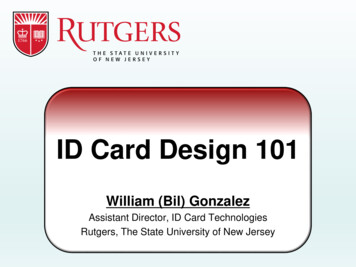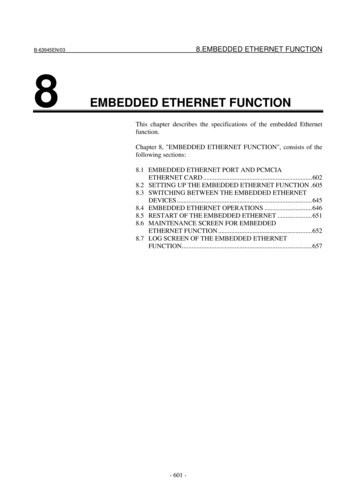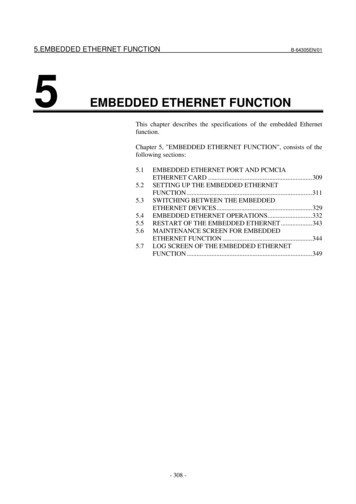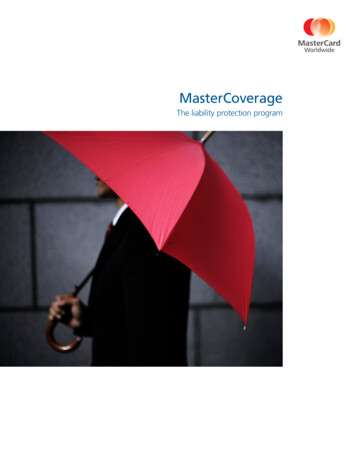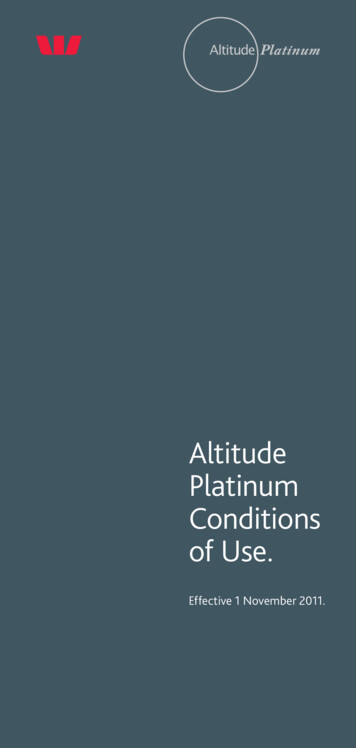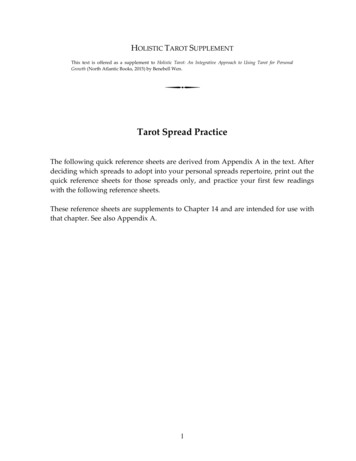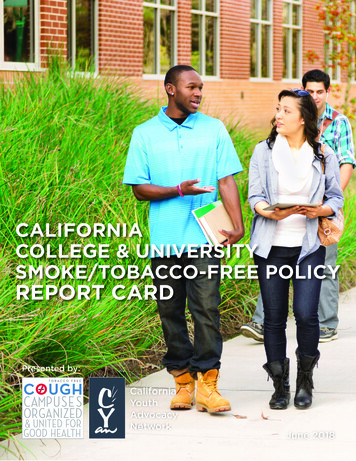
Transcription
CALIFORNIACOLLEGE & UNIVERSITYSMOKE/TOBACCO-FREE POLICYREPORT CARDPresented by:CaliforniaYouthAdvocacyNetworkJune 2018
Suggested Citation:California Youth Advocacy Network (2018). California College and University Smoke/Tobacco-Free PolicyReport Card. Sacramento, CA.This material was made possible with funds received from the California Department of Public Health,under contract #14-10013.California College and University Smoke/Tobacco-Free Policy Report Card 2018, California Youth Advocacy Network2
Main Heading Long or Short2018 College and University Report CardCalifornia Public College and University Smoke and Tobacco-Free Policy RatingsINTRODUCTIONTobacco is the leading cause of preventable and premature death, accounting for anestimated 480,000 American deaths in the United States each year, or one out of everyfive deaths.The young adult years (18-25 years old) are an especially critical time in the developmentof a tobacco addiction. The tobacco industry is aware of this, aggressively marketing itsproducts to young people in an attempt to generate a new cohort of lifetime tobaccousers. As cigarette smoking rates continue to decline, use of alternative tobacco products,including flavored products such as electronic smoking devices, is increasing. InCalifornia, young adults have the highest prevalence of e-cigarette use compared to anyother age group population.1One effective strategy for preventing young people from becoming addicted to tobaccoand supporting those who are in quitting is the adoption of smoke and tobacco-freepolicies. Smoke and tobacco-free environments positively shift social norms againsttobacco use. For these reasons, the young adult years are also a critical time to ensuretobacco-free environments. Despite this, college campuses often act as a stronghold oftobacco-use, a place where smoking and vaping are still the norm, in an increasinglytobacco and smoke-free world.CONTENTSIntroduction.3Policy Rationale .4In order to counter the negative effects of tobacco on the college population, the AmericanCollege Health Association (ACHA) has recommended all colleges and universities adopt a100% smoke/tobacco-free campus policy. Furthermore, organizations such as CVS Health,the American Cancer Society, and The Truth Initiative are contributing significant grantfunding to college campuses across the nation in an effort to produce the first tobacco-freegeneration.Equitable Policies.7Since 1998, the California Youth Advocacy Network (CYAN), a project funded bythe California Tobacco Control Program, has been supporting California colleges anduniversities in creating healthy campus environments by adopting and implementingsmoke/tobacco-free policies. CYAN’s College Program is the longest running programfocused on tobacco-free college campuses in the nation. In 2002, a group of studentsformed COUGH (Campuses Organized and United for Good Health), a statewidemovement committed to promoting, establishing, and sustaining safer and healthiercolleges through tobacco-free policy education, and cessation. Together, CYAN andCOUGH have been working to advance the success of 100% smoke/tobacco-free policieson all institutions of higher learning in California.CSU Report Card.15Scoring Methodology.8Report Findings.11Conclusion.13 UC Report Card.14 Community CollegeReport The California College & University Smoke/Tobacco-Free Policy Report Card is acollaborative project of CYAN and COUGH. The Report reviews and assesses currenttobacco use policies on all 147 public colleges and universities in the state. The firststatewide Report was released in June 2016.The purpose of this Report is to reveal tobacco use policy trends on campuses inCalifornia. Additionally, the aim of the Report Card is to educate and encourage collegedecision makers to adopt comprehensive smoke/tobacco-free policies that promote healthand wellness for all members of their campus community.California College and University Smoke/Tobacco-Free Policy Report Card 2018, California Youth Advocacy Network3
Smoke/Tobacco-Free Policy RationaleIn recent years, the adoption of smoke/tobacco-free policies on college campuses nationwidehas seen a dramatic increase. In Spring 2008, approximately 75 colleges had 100% smoke-freepolicies. Ten years later, that number has risen dramatically with 2,164 U.S. and tribal colleges anduniversities adopting 100% smoke-free policies. Of these campuses, 1,805 schools are 100% smokeand tobacco-free and prohibit the use of all tobacco products on college/university property.2DECREASE EXPOSURE TO SECONDHAND SMOKE Since the 1964 Surgeon General’s Report, 2.5 million adults whowere nonsmokers died because they breathed secondhand smoke.320112012CA PUBLIC COLLEGES AND UNIVERSITIES:100% SMOKE OR TOBACCO-FREE The US Environmental Protection Agency (EPA) has found secondhand tobacco smoke tobe a risk to public health and has classified secondhand smoke as a group A carcinogen, themost dangerous class of carcinogen. 4 The California Air Resources Board has categorized secondhand smoke as a toxic aircontaminant, the same category as diesel exhaust.5 The Surgeon General of the United States concluded that there is no risk-free level ofexposure to secondhand smoke and establishing smoke-free environments is the only provideway to prevent exposure.6CHANGE TOBACCO USE BEHAVIOR A study published in the British Medical Journal (2002) concluded that tobacco userswho worked in a completely smoke-free environment were more likely to quit than theircounterparts working in areas without strong smoke-free policies. Additionally, individualsworking in smoke-free environments were more likely to decrease the number of cigarettesthey smoked throughout the day.7 Smoke-free campus policies are proven to decrease current smoking prevalence in students,decrease the amount of cigarettes used by those who continue to smoke, positively influencestudents’ perceptions of peer smoking, change social norms around tobacco use, and increasefavorable attitudes towards regulation of tobacco. These findings are consistent with a studythat found that college students who lived in smoke-free residences were more likely to benonsmokers.8California College and University Smoke/Tobacco-Free Policy Report Card 2018, California Youth Advocacy Network420182010201718% 25% 27% 32% 38% 51% 59%201611%20159%20148%20135%2009As more institutions of higher education adopt and implement strongtobacco use policies, we gain a greater understanding of the impactof these policies. This knowledge along with findings from researchconducted on the impact of other smoke and tobacco-free policiesprovide a strong rationale for why colleges and universities across thenation continue to adopt 100% smoke/tobacco-free policies.2008National trends are consistent with what has been observed in California. In Spring 2008,only eight (5%) public colleges in the state were 100% smoke or tobacco-free. By Spring2018, 87 (59%) of public colleges and universities in California are now 100%smoke or tobacco-free.
DECREASE TOBACCO LITTER ON CAMPUS Cigarette waste is extremelytoxic to our environment.Cigarette butts contain thesame toxic chemicals intobacco smoke. The smallfilter, when wet, releasesthousands of toxic chemicalsback into the environment.These filters and chemicalsare washed into waterways bywater runoff.9 Tobacco waste is commonon campuses that arenot smoke/tobacco-free.A 2010 study of litterUC San Diego and San DiegoState University revealed thatin 80 volunteer hours, 31,410cigarette butts were collectedbetween the two campuses. Thisrepresented about 380 butts per volunteer per hour.10 100% smoke/tobacco-free policies are associated with reduced tobacco waste near buildingentrances compared with campuses with weaker policies. These reductions may reflect fewercigarettes smoked near buildings and reduced exposure to secondhand smoke.11 By eliminating tobacco litter, colleges are also decreasing fire risk on campus, decreasing thecost and time associated with cleaning up tobacco litter, and increasing campus beautification.atPROMOTE STUDENT SUCCESS Reducing the number of students that start using tobacco as well as the amount of tobacco thatstudents use, smoke and tobacco-free policies help students persist to graduation by having apositive impact on their health. Historically, most tobacco users started smoking or using smokeless tobacco before the age of 18.Over the last ten years, this pattern of new addiction has been changing. A recent study foundone-fifth of smokers reported starting after the age of 18. Among individuals who started usingtobacco before 18, regular or daily smoking was not established until the ages of 20 or 21.12 As students graduate, they are transitioning into tobacco-free environments. In California, themajority of hospital and K-12 campuses are 100% smoke-free or tobacco-free. Nationwide,worksites, college campuses, health care centers, and outdoor recreational facilities are adoptingcomprehensive tobacco use policies.California College and University Smoke/Tobacco-Free Policy Report Card 2018, California Youth Advocacy Network5
DECREASE EXPOSURE TO NEW AND EMERGING TOBACCO AND NICOTINEPRODUCTS Use of new products, such as electronicsmoking devices, is increasing among someage groups and is higher than combustibletobacco among youth and young adults.13,14 In California, young adults are three timesmore likely to use e-cigarettes than those 30and older.15 Through the use of flavors and appealing new designs, a new generation of young people arebecoming addicted to nicotine and are becoming regular tobacco users.16, 17 New and emerging products may introduce young adults to tobacco use or promote dual use ofcigarettes and smokeless tobacco products.18 Hookah use has surpassed cigarette use among U.S. young adult college students.19 E-cigarette vapor is a new source of volatile organic compounds (VOCs) and ultrafine/fineparticles.20 Use of products that mimic tobacco use, specifically e-cigarettes, may renormalize smokingand challenge the implementation and enforcement of tobacco-free policies that are proven todecrease tobacco use.California College and University Smoke/Tobacco-Free Policy Report Card 2018, California Youth Advocacy Network6
Approaching Health Equity with EquitableSmoke and Tobacco-Free PoliciesIn 2013, the Health Services Association of California Community Colleges (HSACCC) wrotea White Paper on Tobacco Prevention and Control in the California Community Colleges toencourage the creation of 100% smoke/tobacco-free environments at all 113 community collegecampuses (there are now 114 campuses).In February 2014, the California Tobacco Control Program published the report, AdvancingHealth Equity in Tobacco Control. The report identifies 11 priority strategies for reducingtobacco-related health disparities. Included on this list is the establishment of smoke/tobaccofree two-year colleges (community colleges and trade/technical schools). California communitycolleges serve 2.1 million students and, collectively, is the largest system of high educationin the U.S. Sixty-seven percent of community college students are people of diverse ethnicbackground.21 In California, large differences in smoking prevalence exist among adults, youngadults, and youth by race/ethnicity and among population groups by socioeconomic status,education, occupation, mental health status, sexual orientation, and geography.California’s community college and trade and tech school students are disproportionallyimpacted by the death and disease caused by tobacco, and yet they are the last to beprotected by smoke and tobacco-free policies. The University of California Office of thePresident adopted a smoke and tobacco-free policy in January of 2012 and the systemwidepolicy was implemented on all 15 UC campuses by January 2014. More recently, a similar policywas adopted by the California State University Chancellor’s Office making all 23 campuses100% smoke and tobacco-free in September 2017. The “A ” grades for all 33 four-year publicuniversities were included in this report both to show the difference between the systems as wellas to commend these institutions for protecting the health of their students, staff, and visitors.An executive order is not possible under state law in the California Community Collegesystem and so the authority to adopt smoke and tobacco-free policies continues to lie withthe 72 community college districts and 114 campuses. However, in May 2018, the Board ofGovernors for the Community College system adopted a resolution providing supportand recommendations to all community colleges in the state to make their campuses100% smoke and tobacco-free. CYAN and COUGH commend the Board of Governors and theChancellor’s Office for taking the strongest action possible under the law to try to address thisgap in protections for their students and staff.California College and University Smoke/Tobacco-Free Policy Report Card 2018, California Youth Advocacy Network7
Scoring MethodologyCYAN maintains a database of tobacco use policies from all public colleges and universities inCalifornia. Policies have been collected and analyzed since 2001. The database is updated aminimum of two times per academic year. CYAN staff and COUGH student leaders utilize thedatabase to track progress on the adoption and implementation of smoke/tobacco-free policies.DATA COLLECTIONThe policies found in CYAN database are collectedfrom college/university websites, school catalogs,campus administrations, and District governingboards (California Community College system).Print copies of these policies are kept on file andthe date of collection and review is noted on thepolicy. If CYAN is unable to locate an officialwritten policy, the policy noted in the college/university catalog and/or manuals is collected aspolicy on file.CATobaccoFreeColleges.orgDATE OF POLICY REVIEWCOUGH students and CYAN staff did an extensive policy review of all 147 public college anduniversity policies in April and May 2018. Policies officially adopted by May 21, 2018, werereviewed for this Report. If a college/university adopted a policy but the policy has not beenimplemented, the officially adopted policy is what was reviewed and scored. If a college isconsidering a new policy but it has not been finalized and signed by administration, the currentpolicy implemented on campus is the policy that was scored for this report.COMMUNITY COLLEGES: DISTRICT POLICIES VERSUS CAMPUS POLICIESCommunity college districts have the authority to regulate tobacco use on the campuses withintheir district. Some districts create district-wide smoke/tobacco-free policies for all of thecolleges within their jurisdiction while others have a standard policy for the district but allowindividual colleges to adopt stronger policies. Regardless of who has the authority to adopt asmoke/tobacco-free policy (i.e., district versus campus), CYAN reviewed the tobacco use policyfrom all 114 community college campuses. In many cases, these policies were the same as thedistrict policy. In some cases, a college’s policy was either stronger or weaker than the districtpolicy. If a campus policy was found to be weaker than the district policy, the campus policyis the policy that was scored. The Report authors recognize district policies are the minimumpolicy a college must have; however, if a college’s policy is weaker than a district’s policy, it isnoted in this report in order to encourage administration to strengthen their smoke/tobacco-freepolicy to the district policy or stronger.California College and University Smoke/Tobacco-Free Policy Report Card 2018, California Youth Advocacy Network8
POLICY ANALYSIS AND GRADINGAll public college/university tobacco use policies were reviewed and scored using the samescoring instrument. Only written policies were analyzed for this report. CYAN did not take intoconsideration how well a policy was implemented or enforced.A total of seven policy types were identified and used to score policies including:1. 100% Smoke/Tobacco-Free, including Electronic Smoking Devices – Smoking, the use oftobacco products, and the use of electronic smoking devices are prohibited on all indoorand outdoor property. Products covered under this policy include, but are not limited to,cigarettes, cigars, pipes, water pipes (hookah), e-cigarettes, chewing tobacco, spit tobacco,snus, snuff, and dissolvable tobacco products.2. 100% Smoke/Tobacco-Free - Smoking and the useof tobacco products are prohibited on all indoorand outdoor property. Products covered under thispolicy include, but are not limited to, cigarettes,cigars, pipes, water pipes (hookah), chewing tobacco,spit tobacco, snus, snuff, and dissolvable tobaccoproducts.NO WRITTEN POLICY, 2%3. 100% Smoke-Free – Smoking of tobacco productsis prohibited on all indoor and outdoor property.Products covered under this policy include, but arenot limited to, cigarettes, cigars, pipes, and waterpipes (hookah).ENTRYWAY, 8%DESIGNATED AREAS, 20%PARKING LOTS, 12%100% SMOKE-FREE, 10%100% SMOKE/TOBACCO-FREE, 48%4. Parking Lots Only – Smoking and/or the use oftobacco products is prohibited on campus with theexception of parking lots or designated areas in parking lots.5. Designated Smoking Areas - Smoking and/or the use of tobacco products is prohibited oncampus with the exception of designated smoking areas on campus.6. Perimeter or Entryways – Smoking and/or the use of tobacco products is prohibited within acertain distance from buildings, entranceways, exits, windows, and/or air intake units. Policymust prohibit smoking 20-ft or more from buildings (current state law prohibits smokingwithin 20-ft of state-owned buildings).7. Policy not in compliance with current state law (no smoking within 20-ft of buildings).If an institution’s smoke/tobacco-free policy included language on electronic smoking devices ore-cigarettes, the campus was awarded 5 bonus points. Colleges with 100% smoke/tobacco-freepolicies, including e-cigarettes, did not receive additional bonus points as the points were buildin to the final score.California College and University Smoke/Tobacco-Free Policy Report Card 2018, California Youth Advocacy Network9
Once scores were finalized, colleges were assigned a grade based on the policy score theyreceived.OVERALL SMOKE/TOBACCO-FREE POLICY GRADESPOLICY TYPESCOREGRADE100% smoke/tobacco/vape-free100 POINTSA 100% smoke/tobacco-free95 POINTSA100% smoke-free, including e-cigarettes90 POINTSA100% smoke-free85 POINTSBParking lots only, including e-cigarettes75 POINTSCParking lots only70 POINTSCDesignated smoking areas, including e-cigarettes65 POINTSDDesignated smoking areas60 POINTSDPerimeter or Entryways, including e-cigarettes35 POINTSFPerimeter or Entryways30 POINTSF0 POINTSFNo written policy or policy not in compliance with currentstate lawRationale for low scores for Parking Lots Only and Designated Smoking Area policiesCYAN applauds administrators who have adopted outdoor air policies to reduce secondhandsmoke on campus. Designated smoking areas may seem like a good idea to allow tobaccousers a place to smoke; however, they have many more disadvantages than benefits. A studyfrom Stanford University found that in outdoor designated areas with multiple smokers, levelsof toxic air contaminants from secondhand smoke may be the same or higher than indoors,therefore, creating a hazardous environment to individuals standing in or around these areas.Additionally, secondhand smoke is proven to travel outside of designated areas; distance dependson wind strength and areas have also been found to encourage tobacco use by creating a socialenvironment for daily and non-daily tobacco users. By increasing the number of individualssmoking in one area, students are more likely to believe that more people smoke than actuallydo. This misperception affects the norm of smoking on campus and may also contribute toincreased tobacco use. Finally, designated areas are often heavily littered and smell of toxictobacco waste. Unless regularly cleaned and maintained, these areas are unhealthy, smelly, and aneyesore.California College and University Smoke/Tobacco-Free Policy Report Card 2018, California Youth Advocacy Network10
Report FindingsSTRONG COMPREHENSIVE POLICIESAs of May 2018, 87 of California 147 public colleges anduniversities are 100% smoke-free. Of these, 71 campuses are100% smoke and tobacco-free, including e-cigarettes. During the2017-2018 academic year, 11 campuses adopted a 100% smokeor tobacco-free policy, including e-cigarettes. All 11 of thesenew policies were adopted by a California Community College.Within the last few years, the majority of institutions strengthentheir policies to address the use of all tobacco products (includinge-cigarettes) versus smoke-free or designated areas policies.8714787 OF CALIFORNIA’S 147 PUBLICCOLLEGES AND UNIVERSITIES ARE100% SMOKE OR TOBACCO-FREESMOKE/TOBACCO-FREE POLICIES BY SYSTEMUNIVERSITY OF CALIFORNIAThe University of California (UC) system, including 10 educationalcampuses and five medical hospitals is 100% smoke and tobacco-free,including e-cigarettes. The entire system went smoke and tobaccofree in January 2014 after a systemwide policy was adopted by theUniversity of California Office of the President in January 2012(UCLA, UCSF, and UCSD implemented policies prior to this date).100%SMOKE/TOBACCO-FREEINCLUDING E-CIGARETTESUNIVERSITY OFCALIFORNIA2014CALIFORNIA STATEUNIVERSITY2017CALIFORNIA STATE UNIVERSITYIn April 2017, the California State University system adopted a 100%smoke and tobacco-free policy, including e-cigarettes. The executive order signed by ChancellorWhite, required all 23 CSU campuses to implement a comprehensive smoke/tobacco-free policyby September 1, 2017. The systemwide policy has resulted in all public four-year universities inCalifornia being 100% smoke/tobacco-free institutions.CALIFORNIA COMMUNITY COLLEGESCurrently 46% (53/114) of California Community Colleges are100% smoke or tobacco-free. Of these, 38 campuses are 100%smoke/tobacco-free, including e-cigarettes and 15 are 100%smoke-free, including e-cigarettes.In May 2018, the Board of Governors for the CaliforniaCommunity College system adopted a resolution to provideguidance and support for all 114 California community colleges toadopt and implement 100% smoke and tobacco-free policies.46%100% SMOKE OR TOBACCO-FREECalifornia College and University Smoke/Tobacco-Free Policy Report Card 2018, California Youth Advocacy Network11
In most cases, community collegedistrict governing bodies have adoptedpolicies that apply to all property ownedor operated by the district. However,in some cases, district leadershipdesignates policy-making authority tolocal campus administrators. Policiesspecific to a local campus versus adistrict-wide policy are noted with anasterisk (*) in the Community CollegeReport Card.FOUR-YEAR INSTITUTIONS VS. TWO-YEAR INSTITUTIONSThere are stark differences in the type of tobacco use policies adopted and implemented by fouryear universities compared to community colleges. California is home to 33 public four-yearinstitutions (10 UC, 23 CSU) and 114 two-year colleges. When comparing data collected fromUC/CSU campuses and community colleges, some interesting findings were % SMOKE OR TOBACCO-FREEINCLUDE E-CIGARETTES IN POLICIESREGIONAL DATAWhen looking specifically at community college policies, one of the standout regions is Region Xin San Diego where all community colleges are 100% smoke and tobacco-free. Another area thatshines is Region II in Sacramento and surrounding counties where all but three campuses are100% smoke and tobacco-free, as of 2017. Finally, three districts in Region III in the Bay Areahave made substantial progress this past academic year making over half of the campuses in theregion 100% smoke-free, including e-cigarettes.California College and University Smoke/Tobacco-Free Policy Report Card 2018, California Youth Advocacy Network12
ConclusionCurrent California law prohibits smoking within20-ft of a main exit, entrance, or operable windowof a public building, including colleges anduniversities. The law allows California CommunityCollege campuses, campuses of the CaliforniaState University, and campuses of the Universityof California to adopt and enforce additionalsmoking and tobacco control policies that are morerestrictive than the law.During the 2016 legislative session,Assemblymember Kevin McCarty (D-Sacramento)introduced Assembly Bill (AB) 1594, a bill thatwould have made all California public collegesand universities 100% smoke/tobacco-free, including electronic smoking devices. The bill hadno public opposition and was approved by the Senate Floor 26-12 (1 member abstaining/notvoting) and the Assembly Floor 52-27 (1 member abstaining/not voting). On September 26,2016, Governor Brown vetoed the bill stating, “the governing boards of our public colleges anduniversities already have the authority and are full capable of setting smoking policies on theircampuses.”Even though AB 1594 was vetoed, the bill had an impact on smoke/tobacco-free policies onCalifornia colleges and universities as many institutions began discussing how and when tostrengthen their policies. In April 2017, the CSU Chancellor’s Office signed an executive ordermaking all University-owned and leased property 100% smoke/tobacco-free. In May 2018, theBoard of Governors for the California Community College system adopted a resolution urging allcampuses to adopt 100% smoke and tobacco-free policies. During the 2017-2018 academic year,10 community colleges adopted a 100% smoke or tobacco-free policy, including e-cigarettes. Itis the hope of CYAN and COUGH that this resolution leads to a smoke/tobacco-free communitycollege system by 2023.A strong body of evidence exists that supports the adoption and implementation of 100% smoke/tobacco-free policies. California colleges and universities have made good progress on restrictingtobacco use and exposure on campus. It is the hope of CYAN and COUGH that communitycolleges will continue to work on comprehensive smoke/tobacco-free policies that promote goodhealth and protect campus communities from the negative effects of tobacco. We look forward topartnering with all California colleges and universities as they move forward with adopting andimplementing these policies or continue working on increasing policy compliance.California College and University Smoke/Tobacco-Free Policy Report Card 2018, California Youth Advocacy Network13
University of California Report Cardreelawree-F seas ore)eFortcaAotctedngba ok g elessI(20/odooerytemLtcSinatSmSm ingeteoliareegn% ELEYXX100A DAVISXX100A IRVINEXX100A LOS ANGELESXX100A MERCEDXX100A RIVERSIDEXX100A SAN DIEGOXX100A SAN FRANCISCOXX100A SANTA BARBARAXX100A SANTA CRUZXX100A California College and University Smoke/Tobacco-Free Policy Report Card 2018, California Youth Advocacy Network14
California State University Report CardreeeeFlawas)reeeForrtsocctestadmogAnba aretnracciedeaoobekuhrTlotgot/-f/T-FIncke e-ciSmsess20keketols(/odooegrtcySm dinSmSm ing L gnatereteteoliae%u%mg%piliik0 ncs00rrore Gradcoeea0c10N10PiDSPE1BAKERSFIELDXX100A CHANNEL ISLANDSXX100A CHICOXX100A DOMINGUEZ HILLSXX100A EAST BAYXX100A FRESNOXX100A FULLERTONXX100A HUMBOLDTXX100A LONG BEACHXX100A LOS ANGELESXX100A MARITIME ACADEMYXX100A MONTEREY BAYXX100A NORTHRIDGEXX100A POMONAXX100A SACRAMENTOXX100A SAN BERNARDINOXX100A SAN DIEGOXX100A SAN FRANCISCOXX100A SAN JOSEXX100A SAN LUIS OBISPOXX100A SAN MARCOSXX100A SONOMAXX100A XX100A STANISLAUSCalifornia College and University Smoke/Tobacco-Free Policy Report Card 2018, California Youth Advocacy Network15
Community Colleges by RegionREGION 1REGION 6REGION 2REGION 7REGION 3REGION 8REGION 4REGION 9REGION 5REGION 10California College and University Smoke/Tobacco-Free Policy Report Card 2018, California Youth Advocacy Network16
REGION 1DistrictButte-GlennFeather RiverLassenRedwoodsShasta-TehamaTrinitySiskiyou Joint CAMPUS NAMEeesFrlawreeeae)eFo esrrtcoaAtctcongr m an s udedba aretaceioobekrtothcle/T cigmo 20-fe-F tse/TInssSekksok g el(oo/doeSm dinter olicy arettateSm ng LSmeneepsig0% ncluad0% arki0%rimorcigroe0e00cG1PS1DEi1PNBUTTEXX65DFEATHER RIVERXX65DX35FX100A X65D60DXLASSENCOLLEGE OF THEREDWOODSXSHASTAXCOLLEGE OF THESISKIYOUSXREGION 2Los RiosAMERICAN RIVERXX100A COSUMNES RIVERXX100A FOLSOM LAKEXX100A SACRAMENTO CITYXX100A X65DLake TahoeLAKE TAHOEXMendocino-LakeMENDOCINOX60DNapa ValleyNAPA VALLEYX60DSierra JointSIERRAXX100A SOLANOXX100A WOODLANDXX100A YUBAXX100A SolanoYubaCalifornia College and University Smoke/Tobacco-Free Policy Report Card 2018, California Youth Advocacy Network17
REGION 3DistrictContra Costa CAMPUS NAMEeesFrlawreeeae)eFo esrrtcoaAtctcongr m an s udedba aretaceioobekrtothcle/T cigmo 20-fe-F tse/TInssSekksok g el(oo/doeSm dinter olicy arettateSm ng LSmeneepsig0% ncluad0% A A CDAX75CMERRITTXXXX9090AACITY COLLEGE OFSAN FRANCISCOXX90ACONTRA COSTADIABLO VALLEYXXXLOS MEDANOS*MarinPeraltaXCOLLEGE OF MARINXBERKELEY CITYCOLLEGE OFALAMEDAXLANEYSan FranciscoSan Mateo CountyCANADA*XX75CCOLLEGE OF SANMATEO*XX75CX65DX100A X90AX75CXXXXX65757575100DCCCA 70C90A70CX90AXSKYLINE*Sonoma CountySANTA ROSAJUNIORXREGION 4CabrilloChabot-LasPositasXCABRILLOXCHABOTXLAS POSITASFoothill-De AnzaXXXDE ANZAFOOTHILLGavilan
smoke/tobacco-free policies. CYAN’s College Program is the longest running program focused on tobacco-free college campuses in the nation. In 2002, a group of students formed COUGH (Campuses Organized and United for Good Health), a statewide movement committed to pr
